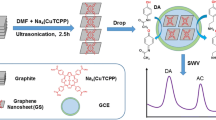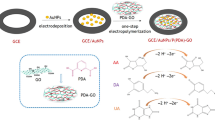Abstract
A selective determination of levodopa (LD) in the presence of ascorbic acid (AA) and uric acid (UA) has been investigated at a glassy carbon electrode modified with reduced graphene oxide (rGO). The graphene oxide was synthesized chemically by Hummers method and characterized by energy-filtered transmission electron microscopy (EF-TEM). The reduced graphene oxide modified glassy carbon electrode (rGO/GCE) showed excellent electrochemical performance in the simultaneous electrochemical detection of LD, AA, and UA due to the unique properties of graphene, such as large surface area, facile electronic transport and high electrocatalytic activity. The redox characteristics of rGO/GCE were investigated with cyclic voltammetry (CV) and differential pulse voltammetry (DPV). Well-resolved oxidation peak potentials, corresponding to the oxidation of AA, LD, and UA, were observed from their mixture solution at 0.098, 0.285, and 0.423 V, respectively. The rGO/GCE showed that LD can be detected without the interference of AA and UA. Under the optimized conditions, the oxidation peak current of LD is linear with the concentration of LD from 2.0 to 100 μM with the detection limit of 1.13 μM (S/N = 3). The present electrode system was also successfully applied to direct determination of LD in commercially available tablets and urine samples.








Similar content being viewed by others
References
Hardy J, Gwinn-Hardy K (1998) Genetic classification of primary neurodegenerative disease. Science 282:1075–1079
Schapira AHV (2005) Present and future drug treatment for Parkinson’s disease. J Neurol Neurosurg Psychiatry 76:1472–1478
Katzenschlager R, Lees AJ (2002) Treatment of Parkinson’s disease: levodopa as the first choice. J Neurol 249(2):19–24
Fauci AS, Braunwald E, Kasper DL, Hauser SL, Longo DL, Jameson JL, Loscalzo J (2008) Harrison’s principles of internal medicine, Chap 366, 17th edn. McGraw-Hills, New York
Barbeau A (1974) The clinical physiology of side effects in long-term L-DOPA therapy. Adv Neurol 5:347–365
Laitinen LV, Bergenheim AT, Hariz MI (1992) Leksell’s posteroventral pallidotomy in the treatment of Parkinson’s disease. J Neurosurg 76:53–61
Melamed E, Offen D, Shirvan A, Ziv I (2000) Levodopa—an exotoxin or a therapeutic drug? J Neurol 247:135–139
Zhu M, Huang XM, Li J, Shen HX (1997) Peroxidase-based spectrophotometric methods for the determination of ascorbic acid, norepinephrine, epinephrine, dopamine and levodopa. Anal Chim Acta 357:261–267
Grunhut M, Centurion ME, Fragoso WD, Almeida LF, de Araujo MCU, Band BSF (2008) Flow-batch technique for the simultaneous enzymatic determination of levodopa and carbidopa in pharmaceuticals using PLS and successive projections algorithm. Talanta 75:950–958
Kaur K, Malik AK, Singh B, Godarzi M (2009) Simultaneous spectrophotometric determination of carbidopa and levodopa by partial least squares regression, principal component regression and least squares support vector machine methods. Thai J Pharm Sci 33:123–136
Marques KL, Santos JL, Lopes JA, Lima JL (2008) Simultaneous chemiluminometric determination of levodopa and benserazide in a multi-pumping flow system with multivariate calibration. Anal Sci 24:985–991
Zhao S, Bai W, Wang B, He M (2007) Determination of levodopa by capillary electrophoresis with chemiluminescence detection. Tlanta 73:142–146
Cannazza G, Di Stefano A, Mosciatti B, Braghiroli D, Baraldi M, Pinnen F, Sozio P, Benatti C, Parenti C (2005) Detection of levodopa, dopamine and its metabolites in rat striatum dialysates following peripheral administration of L-DOPA prodrugs by mean of HPLC-EC. J Pharm Biomed Anal 36:1079–1084
Li S, Wu H, Yu Y, Li Y, Nie J, Fu H, Yu R (2010) Quantitative analysis of levodopa, carbidopa and methyldopa in human plasma samples using HPLC-DAD combined with second-order calibration based on alternating trilinear decomposition algorithm. Talanta 81:805–812
Muzzi C, Bertocci E, Terzuoli L, Porcelli B, Ciari I, Pagani R, Guerranti R (2008) Simultaneous determination of serum concentrations of levodopa, dopamine, 3-O-methyldopa and α-methyldopa by HPLC. Biomed Pharmacother 62:253–258
Talebpour Z, Haghgoo S, Shamsipur M (2004) 1H nuclear magnetic resonance spectroscopy analysis for simultaneous determination of levodopa, carbidopa and methyldopa in human serum and pharmaceutical formulations. Anal Chim Acta 506:97–104
Thiagarajan S, Chen SM (2007) Preparation and characterization of PtAu hybrid film modified electrodes and their use in simultaneous determination of dopamine, ascorbic acid and uric acid. Talanta 74:212–222
Yan X, Pan D, Wang H, Bo X, Guo L (2011) Electrochemical determination of L-dopa at cobalt hexacyanoferrate/large-mesopore carbon composite modified electrode. J Electroanal Chem 663:36–42
Babaei A, Babazadeh M (2011) Multi-walled carbon nanotubes/chitosan polymer composite modified glassy carbon electrode for sensitive simultaneous determination of levodopa and morphine. Anal Methods 3:2400–2405
Ensafi AA, Arabzadeh A, Karimi-Maleh H (2010) Sequential determination of benserazide and levodopa by voltammetric method using chloranil as a mediator. J Braz Chem Soc 21:1572–1580
Teixeira MFS, Bergamini MF, Marques CMP, Bocchi N (2004) Voltammetric determination of L-dopa using an electrode modified with trinuclear ruthenium ammine complex (Ru-red) supported on Y-type zeolite. Talanta 63:1083–1088
Yaghoubian H, Karimi-Maleh H, Khalilzadeh MA, Karimi F (2009) Electrocatalytic oxidation of levodopa at a ferrocene modified carbon nanotube paste electrode. Int J Electrochem Sci 4:993–1003
Hu G, Chen L, Guo Y, Wang X, Shao S (2010) Selective determination of L-dopa in the presence of uric acid and ascorbic acid at a gold nanoparticle self-assembled carbon nanotube-modified pyrolytic graphite electrode. Sens Actuators B 55:4711–4716
Shahrokhian S, Asadian E (2009) Electrochemical determination of l-dopa in the presence of ascorbic acid on the surface of the glassy carbon electrode modified by a bilayer of multi-walled carbon nanotube and poly-pyrrole doped with tiron. J Electroanal Chem 636:40–46
Raoof JB, Ojani R, Amiri-Aref M, Baghayeri M (2012) Electrodeposition of quercetin at a multi-walled carbon nanotubes modified glassy carbon electrode as a novel and efficient voltammetric sensor for simultaneous determination of levodopa, uric acid and tyramine. Sens Actuators B 166–167:508–518
Novoselov KS, Geim AK, Morozov SV, Jiang D, Zhang Y, Dubonos SV, Grigorieva IV, Firsov AA (2004) Electric field effect in atomically thin carbon films. Science 306:666–669
Heersche HB, Jarillo-Herrero P, Oostinga JB, Vandersypen LMK, Morpurgo AF (2007) Bipolar supercurrent in graphene. Nature 446:56–59
Balandin AA, Ghosh S, Bao WZ, Calizo I, Teweldebrhan D, Miao F, Lau CN (2008) Superior thermal conductivity of single-layer graphene. Nano Lett 8:902–907
Han D, Han T, Shan C, Ivaska A, Niu L (2010) Simultaneou determination of ascorbic acid, dopamine and uric acid with chitosan-graphene modified electrode. Electroanalysis 22:2001–2008
Cui F, Zhang X (2012) Electrochemical sensor for epinephrine based on a glassy carbon electrode modified with graphene/gold nanocomposites. J Electroanal Chem 669:35–41
Tian X, Cheng C, Yuan H, Du J, Xiao D, Xie S, Choi MMF (2012) Simultaneous determination of L-ascorbic acid, dopamine and uric acid with gold nanoparticles-β-cyclodextrin-graphene-modified electrode by square wave voltammetry. Talanta 93:79–85
Li Y, Ran G, Yi WJ, Luo HQ, Li NB (2012) A glassy carbon electrode modified with graphene and poly(acridine red) for sensing uric acid. Microchim Acta 178:115–121
Guo S, Wen D, Zhai Y, Dong S, Wang E (2010) Platinum nanoparticle ensemble-on-graphene hybrid nanosheet: one-pot, rapid synthesis, and used as new electrode material for electrochemical sensing. ACS Nano 4:3959–3968
Kim YR, Bong S, Kang YJ, Yang Y, Mahajan RK, Kim JS, Kim H (2010) Electrochemical detection of dopamine in the presence of ascorbic acid using graphene modified electrodes. Biosens Bioelectron 25:2366–2369
Hummers WS, Offeman RE (1958) Preparation of graphitic oxide. J Am Chem Soc 80:1339
Li M, Huang X, Wu C, Hu H, Jiang P, Tanaka T (2012) Fabrication of two-dimensional hybrid sheets by decorating insulating pani on reduced graphene oxide for polymer nanocomposites with low dielectric loss and high dielectric constant. J Mater Chem 22:23477–23484
Bard AJ, Faulkner LR (2001) Electrochemical methods fundamentals and applications, 2nd edn. Wiley, New York
Venton BJ, Wightman RM (2003) Psychoanalytical electrochemistry: dopamine and behavior. Anal Chem 75:414A–421A
Manjunatha R, Suresh GS, Melo JS, D’Souza SF, Venkatesha TV (2010) Simultaneous determination of ascorbic acid, dopamine and uric acid using polystyrene sulfonate wrapped multiwalled carbon nanotubes bound to graphite electrode through layer-by-layer technique. Sens Actuators B 145:643–650
Yan XX, Pang DW, Lu ZX, Lu JQ, Tong H (2004) Electrochemical behavior of L-dopa at single-wall carbon nanotube-modified glassy carbon electrodes. J Electroanal Chem 569:47–52
Babaei A, Sohrabi M, Taheri AR (2013) Highly sensitive simultaneous determination of L-dopa and paracetamol using a glassy carbon electrode modified with a composite of nickel hydroxide nanoparticles/multi-walled carbon nanotubes. J Electroanal Chem 698:45–51
Babaei A, Babazadeh M (2011) A selective simultaneous determination of levodopa and serotonin using a glassy carbon electrode modified with multiwalled carbon nanotube/chitosan composite. Electroanalysis 23:1726–1735
Naushad Mu, Gupta VK, Wabaidur SM, Alothman ZA (2013) Simultaneous determination of benserazide and levodopa in pharmaceutical tablet, human serum and urine sample by differential pulse voltammetry using modified glassy carbon electrode. Int J Electrochem Sci 8:297–311
Mazloum-Ardakani M, Ganjipour B, Beitollahi H, Amini MK, Mirkhalaf F, Naeimi H, Nejati-Barzoki M (2011) Simultaneous determination of levodopa, carbidopa and tryptophan using nanostructured electrochemical sensor based on novel hydroquinone and carbon nanotubes: application to the analysis of some real samples. Electrochim Acta 56:9113–9120
Babaei A, Taheri AR, Aminikhah M (2013) Nanomolar simultaneous determination of levodopa and serotonin at a novel carbon ionic liquid electrode modified with Co(OH)2 nanoparticles and multi-walled carbon nanotubes. Electrochim Acta 90:317–325
Author information
Authors and Affiliations
Corresponding author
Electronic supplementary material
Below is the link to the electronic supplementary material.
Rights and permissions
About this article
Cite this article
Yi, SY., Lee, JH. & Hong, HG. A selective determination of levodopa in the presence of ascorbic acid and uric acid using a glassy carbon electrode modified with reduced graphene oxide. J Appl Electrochem 44, 589–597 (2014). https://doi.org/10.1007/s10800-013-0649-8
Received:
Accepted:
Published:
Issue Date:
DOI: https://doi.org/10.1007/s10800-013-0649-8




